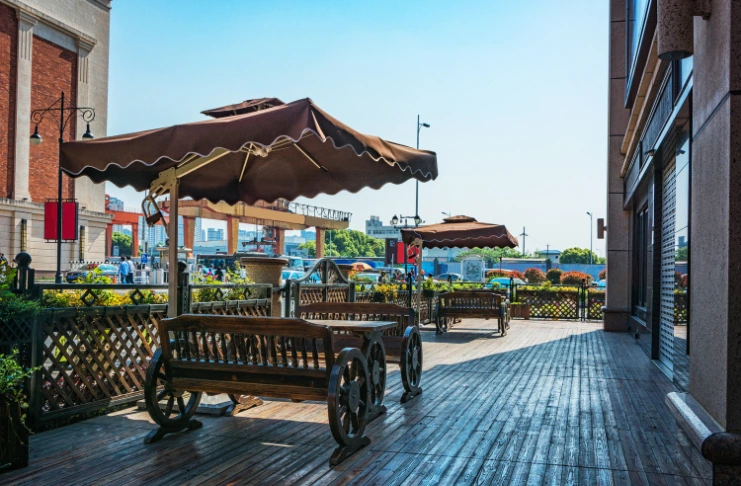When it comes to running a successful restaurant business, one factor stands out above all: location. The right spot can make or break your culinary venture in a heartbeat!
Think about it – Delhi is this incredible melting pot of cultures, tastes, and dining expectations. You’ve got everything from ultra-luxury seekers in Lutyens’ Delhi to college students hunting for budget eats in North Campus. That’s what makes choosing the right restaurant location in Delhi both exciting and challenging.
Whether you’re dreaming of opening that intimate fine-dining spot you’ve been planning for years, a cozy neighborhood café where locals become regulars, or a buzzing QSR that catches the lunch crowd, finding the best location for a restaurant in Delhi requires strategic thinking.
The good news? Delhi offers incredible opportunities in virtually every corner. From the corporate hubs of Connaught Place and Gurgaon to the trendy neighborhoods of Hauz Khas and Khan Market, to the residential goldmines in places like Dwarka and Rohini – your perfect spot is out there waiting.
What’s your vision for your restaurant? Are you targeting families, young professionals, or tourists? Do you need high foot traffic, or are you building a destination spot? Your answers to these questions will shape your new food business and restaurant location checklist and help narrow down neighborhoods that align with your concept.
Let’s dig into what makes Delhi’s restaurant scene so special in terms of food quality and how you can find your perfect spot in this dynamic foodie paradise.
Why Delhi? A Foodie’s Paradise
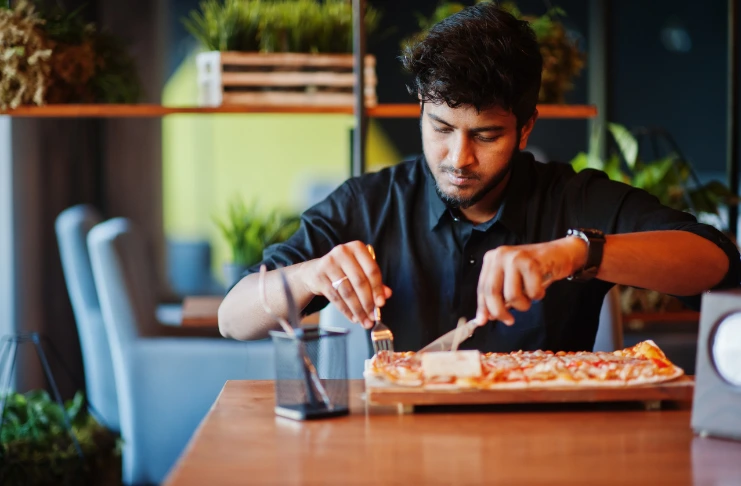
Delhi is not just the political capital of India; it’s also the culinary heart of the country, especially known for its rich indian cuisine . According to a report by NRAI India, Delhi-NCR food market size is Rs 42 thousand crore.
When you think about it, this concentration is absolutely staggering! Nearly one-fourth of India’s entire restaurant industry thrives in this single metropolitan area. This isn’t just coincidence – Delhi’s unique position as a historical, cultural, and economic hub has created the perfect ecosystem for culinary innovation and entrepreneurship.
What makes Delhi truly special is its remarkable food heritage. The city carries centuries of culinary traditions from Mughal kitchens to Punjabi dhabas, colonial influences to modern fusion experiments. Every corner tells a different story! You’ll find fourth-generation kebab makers in Jama Masjid perfecting recipes handed down since the 1900s, while just kilometers away, experimental chefs in Aerocity are crafting molecular gastronomy experiences.
From street food to fine dining, Delhiites embrace culinary diversity. With the right restaurant location strategy in Delhi, you can tap into the ever-evolving tastes of over 33 million people and build a loyal customer base across the NCR region.
This massive consumer base isn’t just large – it’s incredibly diverse. Corporate executives in Gurugram seeking business lunch spots, families in South Delhi looking for weekend dining experiences, college students in North Campus craving affordable yet trendy options, and international tourists exploring Old Delhi’s food lanes – each segment represents a distinct opportunity.
The infrastructure supporting restaurants has evolved, too. The Delhi Metro has revolutionized accessibility, connecting previously isolated neighborhoods and creating new commercial hotspots around stations. Meanwhile, the robust food delivery ecosystem, dominated by platforms like Swiggy and Zomato, has expanded restaurants’ reach beyond their physical locations, like shopping malls.
Seasonality also plays to Delhi’s advantage. While summer months might see reduced foot traffic in outdoor settings, the extended winter season (October through March) creates perfect weather for rooftop dining, outdoor cafés, and food festivals that draw massive crowds.
For restaurateurs with ambitious growth plans, Delhi offers the perfect testing ground. A successful concept here can easily expand to other metros, as Delhi’s cosmopolitan audience often predicts nationwide trends. Many of India’s most successful restaurant chains found their first success in Delhi before expanding nationally.
Delhi’s restaurant scene also benefits from the city’s economic strength. With higher disposable incomes than many other Indian cities, Delhiites spend significantly more on dining out. The pandemic has reshaped dining habits, as approximately 32% of Delhi-NCR’s population stated that their dining out frequency has increased compared to the pre-pandemic times, according to the National Restaurant Association of India’s (NRAI) Food Services Report. However, Delhi’s restaurant industry has shown remarkable resilience and adaptability. New models like cloud kitchens, subscription meal services, and hybrid dining concepts have emerged, creating fresh opportunities for entrepreneurs with innovative ideas and the right location strategy.
1. Understanding the Importance of Location
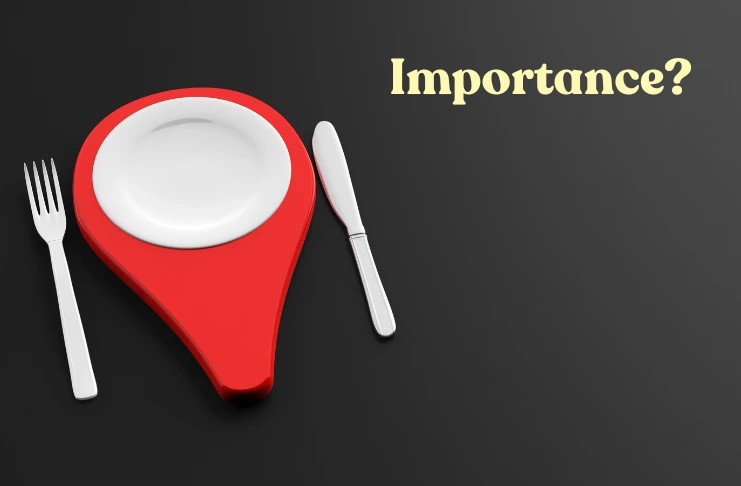
Before you finalize the interiors or the menu, there’s one factor that can single-handedly dictate your restaurant’s success: the location. In Delhi’s dense and diverse foodscape, getting the right spot can mean the difference between a bustling eatery and an empty dining hall. That’s why understanding the nuances of restaurant location in Delhi is your first major step.
Why Location Can Make or Break a Restaurant
Your restaurant’s address isn’t just a pin on the map—it’s a powerful business tool. A great location pulls in people, matches your brand’s vibe, and boosts footfall without spending extra on marketing. Here’s what a great location offers:
- Visibility: A visible location naturally attracts more foot traffic. Whether it’s someone passing by your glowing sign in Connaught Place or a pedestrian in Hauz Khas Village drawn by your quirky storefront, visibility can convert casual passersby into loyal customers. Think of it as free advertising, every single day.
- Accessibility: Even the best food won’t get attention if people struggle to reach you. Locations close to metro stations, main roads, and with available parking make it easier for all types of customers—commuters, families, and delivery agents—to access your place effortlessly.
- Relevance to Concept: Your restaurant’s theme must resonate with the surrounding demographic. A fine-dining Italian place is more likely to flourish in Khan Market or Vasant Kunj than near a student hostel on the North Campus. Always align your concept with your neighborhood’s vibe and spending power.
- Competitive Advantage: Don’t fear a little competition—if the demand is high, clusters can work in your favor. Areas like Hudson Lane or Rajouri Garden are examples where multiple eateries thrive side by side, creating a food destination that pulls larger crowds than any solo spot could.
In short, location isn’t just where your restaurant is—it’s what makes your restaurant work. And in Delhi’s fast-paced market, a strategic spot can help you outperform even better-funded competitors.
Real-Life Insight:
When Social launched in Hauz Khas Village, they capitalized on the youth and nightlife crowd. That single outlet helped shape their identity.
EXPERT INSIGHT
Who better to learn from than those who’ve built successful restaurants across Delhi? Forbes asked one of the leading restaurateurs to share one key piece of advice about choosing a location.
| “Location is everything”, says Riyaaz AmlaniIn the Forbes India article titled “Riyaaz Amlani and His Economics of Fine Dining,” Riyaaz Amlani emphasizes the critical role of location in the restaurant industry. He notes that expanding in the restaurant business necessitates securing locations with sufficient foot traffic to offset initial investments. |
This insight underscores the importance of strategic location selection in the restaurant business, balancing between high footfall areas and the associated costs.
2. How to Choose the Location for a Restaurant in Delhi
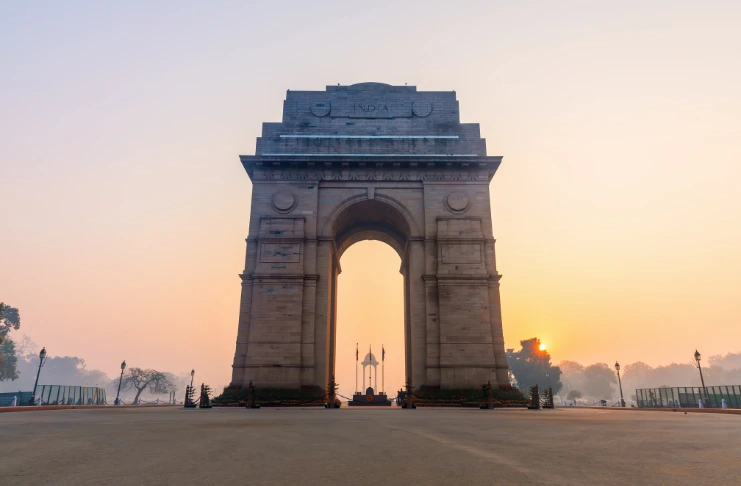
Delhi’s food landscape is vibrant—but saturated. Choosing the right restaurant location is not just about affordability; it’s about alignment with your brand, audience, and long-term growth strategy. Here’s how you can choose the ideal spot step-by-step.
Step-by-Step Guide:
Each decision here sets the stage for your restaurant’s daily footfall and revenue. Skip the guesswork—use these insights to make data-backed choices and avoid costly missteps in Delhi’s dynamic F&B scene.
a. Define Your Target Audience
Before finalizing any location, clearly identify who you’re serving. Are you looking to attract college students seeking quick, budget meals? Or perhaps working professionals who prefer fast lunch combos and coffee pit stops? Maybe it’s families looking for weekend dining options, or tourists wanting local flavor?
Once you know your target group, map their habits. For example:
- College students: Look at Kamla Nagar, GTB Nagar, or Hudson Lane.
- Office-goers: Connaught Place, Nehru Place, or CyberHub are ideal.
- Families: West Delhi’s Rajouri Garden or South Delhi’s Saket offer the right vibe.
- Tourists: CP, Old Delhi, and Paharganj are prime.
Use Delhi demographic maps or neighborhood profiling on websites like Numbeo or MagicBricks to understand local population characteristics.
b. Analyze the Foot Traffic
Footfall equals potential customers. High visibility near metros, markets, malls, or universities ensures more walk-ins without additional marketing. Analyze:
- Google Maps: Use ‘Popular Times’ data for specific locations.
- MyGate (for gated societies): Helps understand footfall patterns in residential areas—ideal if you’re planning a delivery-based or health café model.
Select Citywalk in Saket sees high weekend footfall from families, making it a great pick for mid- to high-end restaurants.
c. Study the Competition
Evaluate your surroundings. Are there already 20 momo stalls in that area? Or is it underserved in your niche, like vegan cafés or health bowls? Use:
- Zomato’s Restaurant Discovery tool to assess cuisines, reviews, pricing, and volume.
- Swiggy Heatmaps (available via business accounts or market research reports) to identify which cuisines are trending and underrepresented.
High competition isn’t always bad. Locations like Hudson Lane thrive because of the variety. Just make sure you stand out.
d. Consider Rental Costs
Rent can make or break your profit margins. In Delhi:
- Budget zones like Laxmi Nagar or Karol Bagh go for ₹100–₹300/sq. ft.
- Mid-tier areas like Rajouri Garden or Kamla Nagar hover around ₹300–₹500/sq. ft.
- Premium hubs like CP or Khan Market touch ₹800/sq. ft. and above.
Make sure your expected revenue justifies the rent. A small, high-footfall kiosk in CP may outperform a large restaurant in an isolated residential block.
e. Check Local Regulations
Delhi’s restaurant laws can be a maze. Even with the perfect location, a missed permit could delay your launch by months. You’ll need:
- FSSAI license (food safety)
- NDMC or MCD trade license (depending on the area)
- Fire NOC from DFS Delhi
- Zonal regulation clearance (ensure commercial usage is permitted)
Don’t skip site inspections! Ensure access to clean water, proper drainage, and fire exits. It’s not just compliance—it’s customer safety.
Following these strategic steps ensures you’re not just picking a location—you’re securing a strong business foundation. In a market as diverse as Delhi, doing your homework upfront can save you lakhs later.
3. Best Location for Restaurant in Delhi – Top Neighborhoods
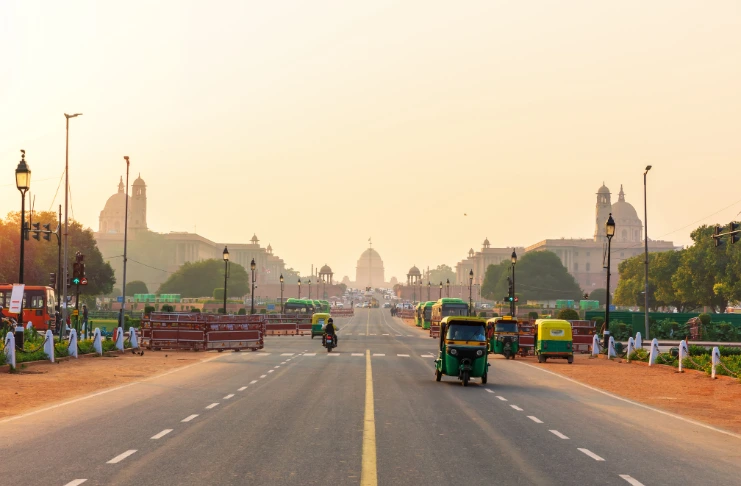
Not all neighborhoods in Delhi offer restaurateurs equal value. Some are bustling gold mines of footfall, while others cater to niche or residential markets. Here’s a breakdown of the best locations for restaurants in Delhi, based on rent, foot traffic, and customer type.
1. Connaught Place (CP)
Best For: Premium cafes, quick-service restaurants (QSRs), bar lounges
Footfall: 80,000+ people daily
Average Rent: ₹500–₹800/sq. ft.
Why Choose It:
- Delhi’s most iconic commercial hub
- Surrounded by offices, hotels, and tourists
- Excellent metro connectivity (Rajiv Chowk)
Popular Restaurants Here: Farzi Café, The Imperial Spice, The Beer Café
2. Hauz Khas Village
Best For: Youth-centric cafes, music lounges, and bars
Footfall: 20,000–30,000+ on weekends
Rent Range: ₹150–₹300/sq. ft.
Why Choose It:
- The bohemian vibe attracts artists, college students
- Strong nightlife and social media appeal
- Close to IIT Delhi, NIFT, and JNU
Popular Restaurants Here: Social, Raasta, Mia Bella
3. Saket & Select Citywalk Area
Best For: Mid-range to high-end casual and fine dining
Footfall: Heavy weekend and evening rush from mallgoers and movie crowds
Rent Range: ₹250–₹500/sq. ft. (inside/outside mall variations)
Why Choose It:
- High-end retail footfall from Select Citywalk, DLF Avenue
- Ideal for family dining, premium QSRs, and global chains
- Ample parking and well-managed infrastructure
Popular Restaurants Here: Mamagoto, Punjab Grill, Sattvik
4. Rajouri Garden
Best For: Casual dining, family restaurants, budget-friendly eateries
Footfall: Strong in evenings and weekends, especially near TDI Mall
Rent Range: ₹250–₹450/sq. ft.
Why Choose It:
- Popular with West Delhi families
- High demand during wedding seasons
- Close to colleges like Rajdhani and Bharti College
Popular Restaurants Here: Berco’s, Barbeque Nation, The G.T. Road
5. Kamla Nagar
Best For: Budget eateries, student cafes, fast food joints
Footfall: High throughout the day due to Delhi University students
Rent Range: ₹200–₹400/sq. ft.
Why Choose It:
- Located next to North Campus
- Ideal for affordable menus and delivery-focused models
- Great for trending food formats (waffles, bubble tea, etc.)
Popular Restaurants Here: Rico’s, Chache Di Hatti, Big Yellow Door (BYD)
6. CyberHub, Gurgaon
Best For: Corporate-centric fine dining and lounge formats
Footfall: High office crowd on weekdays, families on weekends
Rent Range: ₹400–₹700/sq. ft.
Why Include It:
- Technically not in Delhi, but a goldmine for restaurateurs targeting NCR
- Strong after-work dining and bar culture
- Surrounded by MNCs and startup offices
Popular Restaurants Here: SodaBottleOpenerWala, Hard Rock Café, Yum Yum Cha
7. Khan Market
Best For: Elite bistros, organic cafés, fine dining
Footfall: Niche but high-spending clientele
Rent: Among the highest in India (~₹800+/sq. ft.)
Why Choose It:
- Affluent residential and expat neighborhood
- Frequented by diplomats, celebs, and influencers
- Perfect for premium F&B and lifestyle concepts
Popular Restaurants Here: Big Chill, Perch Wine & Coffee Bar, SodaBottleOpenerWala
Location isn’t one-size-fits-all. The right choice aligns with your brand story and audience expectations. Evaluate these zones based on your vision, and pick the one where your restaurant can thrive, not just survive.
4. Types of Restaurant Concepts & Ideal Locations
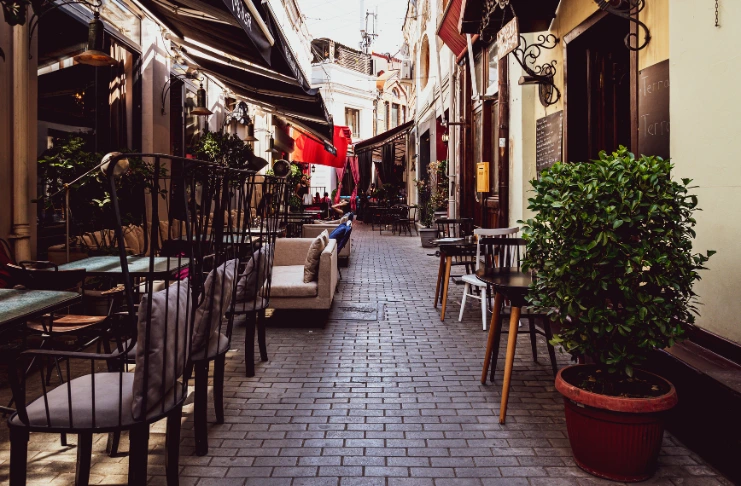
Different restaurant formats demand different environments. A fine-dining space needs elegance and calm; a QSR thrives on speed and visibility. Here’s a handy guide matching restaurant types with their best-fit Delhi neighborhoods.
Fine Dining Restaurants
Best Locations: Khan Market, Connaught Place (CP), Saket
Why Here:
Upscale neighborhoods like these attract an affluent crowd that values ambiance, service, and culinary sophistication. Think curated menus, wine pairings, and elegant interiors.
Fast Food / QSR (Quick Service Restaurants)
Best Locations: Kamla Nagar, Connaught Place, Rajouri Garden
Why Here:
These are fast-paced zones filled with college students, daily commuters, and office-goers who prioritize quick, affordable meals. Ideal for chains, kiosks, and delivery-heavy models.
Cafés & Bistros
Best Locations: Hauz Khas Village (HKV), SDA Market, Civil Lines
Why Here:
Perfect for a young, social-media-savvy crowd that’s always on the lookout for cozy hangouts and aesthetic Instagrammable corners. Great spots for live music, board games, and brunch menus.
Family Dining Restaurants
Best Locations: West Delhi, Rohini, Preet Vihar
Why Here:
These areas are densely residential and home to large families that enjoy frequent outings. Spacious seating, diverse menus, and kid-friendly options work well here.
Health-Focused Cafés
Best Locations: Greater Kailash 1 (GK-1), Vasant Kunj, South Delhi
Why Here:
These neighborhoods are home to fitness-conscious residents and working professionals who prefer organic, vegan, or low-carb options. Great for smoothie bars, keto meals, and salad cafés.
Aligning your restaurant concept with the neighborhood vibe isn’t just smart—it’s essential. Let the city’s pulse guide your location, and your idea will feel right at home. Think of it as choosing the right soil for the kind of tree you want to grow.
5. Restaurant Location Strategy in Delhi: Proven Tactics

Once you know the where, it’s time to figure out the how. A solid restaurant location strategy in Delhi helps you gain an edge in this highly competitive market. These proven tactics can maximize visibility and drive steady footfall to your door.
a. Anchor Your Restaurant Near a Landmark
People always say, “Let’s go somewhere near India Gate” or “near CP!” Positioning your restaurant close to iconic spots such as India Gate, Connaught Place, or Qutub Minar leverages this cultural habit. It also boosts your visibility on Google searches and map listings, making it easier for customers to find and recommend your place. Landmarks act like built-in signposts for foot traffic.
b. Riding on Complementary Businesses
Setting up shop near businesses that attract your ideal customer base is a strategic move. For example, a smoothie or salad bar near a gym, a budget-friendly café next to a college, or a fast lunch outlet near corporate offices can directly tap into the daily routines of your target audience. These synergies increase walk-ins and boost chances of repeat customers due to convenience. It’s about embedding your brand in your customers’ everyday environments.
c. Use Geolocation Marketing
Digital platforms like Facebook Ads and Google Local Campaigns allow you to target people who frequent specific areas or pass by your restaurant regularly. You can run promotions, offer discounts, or highlight new dishes just to people within a 2–3 km radius of your outlet. This method is highly effective in dense urban zones like Delhi, where hyperlocal visibility can drive immediate footfalls, especially when you’re just starting out.
d. High Footfall > Fancy Interiors
While a beautifully designed café can be a visual treat, it means little if it’s hidden in a low-footfall residential alley. A more modest eatery located in a buzzing spot like Connaught Place or Rajouri Garden will almost always generate more foot traffic and revenue. Visibility, accessibility, and natural crowd movement often matter more in Delhi’s fast-paced F&B scene than interiors alone. Balance aesthetic appeal with location-based practicality for long-term success.
Delhi’s geography, traffic patterns, and social habits are unique—leverage these local insights. A thoughtful location strategy can turn your place into a favorite haunt, no matter the competition.
6. New Restaurant Location Checklist

Before you sign that lease, run through this new restaurant location checklist to cover all your legal, logistical, and customer-facing bases. Delhi has its own set of quirks—don’t miss anything crucial.
Here’s a quick but essential restaurant location checklist:
- Legal approvals (FSSAI, Fire NOC, MCD trade license)
- Water and drainage connection
- High-speed internet and delivery logistics
- Proximity to residential/commercial traffic
- Parking space availability
- Competitive analysis in a 1 km radius
- Future real estate developments (e.g., metro lines)
Checking off each point here ensures you launch strong, stay compliant, and avoid last-minute headaches. Think of this as your safety net before diving into Delhi’s bustling restaurant scene.
7. Common Mistakes to Avoid When Choosing Restaurant Location in Delhi

Even experienced restaurateurs fall into common traps—like going for cheap rent or trendy spots without data. Here’s what to avoid when finalizing your restaurant location in Delhi.
- Falling for cheap rents in low-footfall zones
- Ignoring parking & accessibility
- Not researching demographics properly
- Choosing trend over sustainability
- Overestimating the weekend crowd, ignoring weekday sales
By staying alert to these red flags, you can make more informed decisions and sidestep expensive setbacks. Learn from others’ mistakes so your journey starts on solid ground.
8. Real-Life Examples of Location Strategy Success
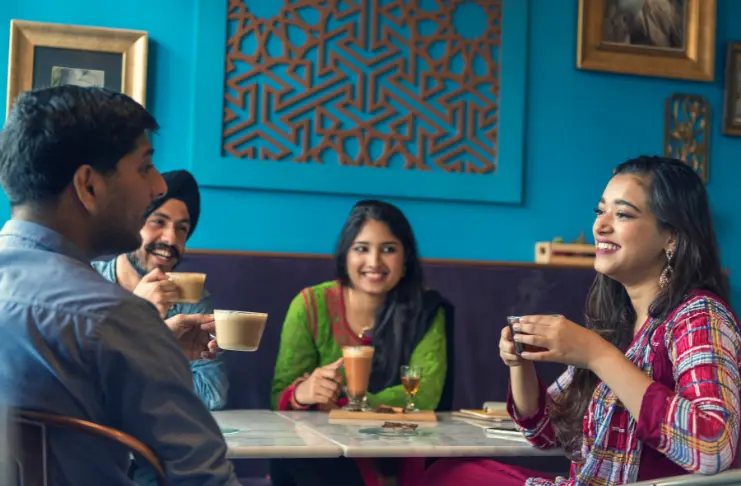
Still unsure if location strategy really works? These real-world examples show how brands in Delhi and NCR used smart site planning to grow into household names.
Biryani Blues
Started near office hubs like DLF Cyber City → focused on delivery → now over 50+ outlets. Biryani Blues began its journey by targeting corporate office areas like DLF Cyber City in Gurgaon, where there’s a constant demand for quick, fulfilling meals. By positioning itself near high-density workspaces, the brand captured a consistent lunchtime and delivery crowd. They leaned heavily into the delivery model — a strategic move that aligned with the fast-paced lifestyle of office-goers.
This hyper-focused location and audience targeting allowed them to optimize operations and scale faster. Over time, the brand expanded beyond NCR and now boasts 50+ outlets across India, maintaining its presence in strategic delivery-first and office-dense areas.
Big Chill
The Big Chill, a cult favorite in Delhi, chose to grow differently. Instead of chasing rapid expansion, it strategically placed its outlets in high-footfall, premium areas like Khan Market, Connaught Place (CP), and Select Citywalk in Saket. These locations are frequented by Delhi’s affluent crowd — a perfect match for Big Chill’s mid-premium positioning and classic European café vibe.
This consistency in high-end locations helped the brand create a legacy of quality and exclusivity. Each outlet reinforces the same upscale, nostalgic dining experience. Their reluctance to dilute the brand with aggressive expansion has earned them unmatched customer loyalty and brand prestige in Delhi NCR.
Every successful brand has a map behind its story. Study these moves, learn what worked, and you’ll be better equipped to make your own location decisions.
9. Tech Tools for Smarter Location Decisions

In today’s data-driven world, gut feeling isn’t enough. Tech tools can help you assess locations with real-time traffic, rental trends, and competition metrics—so you can make decisions that are both smart and scalable. Use these platforms to research and finalize your restaurant location:
- Google Maps: Use Google Maps to analyze competitor density, customer reviews, and real-time traffic heatmaps. It helps identify high-footfall areas, nearby amenities, and optimal routes. This data is crucial for assessing visibility, accessibility, and the surrounding business environments before finalizing your restaurant’s location.
- 99acres / MagicBricks: These real estate platforms offer updated insights on commercial property rentals, sale trends, and locality comparisons. You can evaluate average per sq. ft. costs, landlord expectations, and availability in different neighborhoods of Delhi. Filter by budget, property type, and proximity to key landmarks to refine your decision-making.
- Zomato Restaurant Dashboard: Zomato’s dashboard lets restaurateurs analyze cuisine trends, customer ratings, peak hours, and competitor menus in a specific area. This is invaluable for identifying market gaps, popular price points, and demand patterns — helping you position your restaurant with the right theme, pricing, and food offerings.
- Swiggy Genie & Instamart Data: Swiggy’s backend data provides insights on hyperlocal demand patterns, delivery frequencies, and most-ordered cuisines in a neighborhood. This is especially useful for cloud kitchens or delivery-focused models to understand customer behavior, menu planning, and delivery logistics.
The right tech doesn’t just guide you—it gives you an edge. Use these platforms to filter, analyze, and shortlist locations that align with your restaurant’s long-term vision.
10. Future Trends in Restaurant Location Planning

The way people dine is changing—and so is how they choose where to eat. From ghost kitchens to neighborhood-first models, here are key trends to watch when planning your future restaurant location in Delhi.
- Cloud Kitchens will continue to grow (ideal for East/West Delhi)
- Walk-in culture rising post-COVID (CP footfall bounced back to 2019 levels)
- Tier-2 expansion in NCR (Noida Ext, Dwarka, Rohini) attracting chains
Stay ahead of the curve, and your location won’t just work for today—it’ll grow with tomorrow. Future-ready planning is the difference between temporary success and sustainable impact.
Conclusion
The perfect restaurant location is where your vision meets the market. It’s not just about geography—it’s about connecting with people at the right place, right time, and with the right vibe.
This journey to finding your ideal restaurant spot in Delhi is ultimately about alignment—aligning your culinary dreams with the practical realities of the market. When these elements come together harmoniously, magic happens. Your restaurant doesn’t just survive; it thrives and becomes woven into the fabric of Delhi’s vibrant food scene.
Remember that location hunting is both an art and a science. The data points matter—foot traffic counts, rental costs per square foot, and demographic studies are essential tools in your decision-making toolkit. But equally important is that gut feeling when you stand in a space and can suddenly visualize your tables filled with happy diners, smell your signature dishes wafting from the kitchen, and hear the pleasant buzz of conversation.
Take time to scout, research, and experiment. With Delhi’s evolving food culture, the opportunities are endless—if you’re in the right place. Don’t rush this critical decision. Spend weeks, even months if necessary, visiting potential neighborhoods at different times of day. Observe how people move, where they gather, and what they’re seeking.
Consider testing your concept with pop-ups or food festival appearances in different areas before committing to a permanent location. This approach can provide invaluable insights into how your offerings resonate with different neighborhood demographics.
Delhi’s restaurant landscape continues to transform in fascinating ways. Areas that were once overlooked are becoming the next dining hotspots. Traditional markets are reinventing themselves with modern culinary concepts. Residential neighborhoods are developing their own distinctive food identities. Your challenge—and opportunity—is to anticipate where these trends are heading rather than merely following them.
The most successful restaurateurs in Delhi understand that their physical location is more than a business address—it’s part of their brand story. Whether you’re tucked away in a charming lane in Shahpur Jat, commanding a prime corner in Khan Market, or pioneering a new food destination in an emerging neighborhood, make your location work for you by embracing its unique character and history.
As you embark on this exciting journey, remember that flexibility is key. Be prepared to adapt your concept slightly to better suit your chosen location’s demographics and culture. The restaurants that stand the test of time in Delhi’s competitive marketplace are those that honor their culinary vision while thoughtfully responding to the specific needs and preferences of their neighborhood.
Take time to scout, research, and experiment. With Delhi’s evolving food culture, the opportunities are endless—if you’re in the right place.
Frequently Asked Questions
1. Which area in Delhi is famous for food?
Connaught Place, Chandni Chowk, and Khan Market are iconic for their rich culinary experiences and variety.
2. Where to go to eat street food in Delhi?
Chandni Chowk, Sarojini Nagar, and Lajpat Nagar are top picks for authentic and diverse Delhi street food.
3. Where is the menu restaurant located?
There are multiple restaurants named “Menu”—please specify the full name or area for accurate location info.
4. Which place is located in Delhi?
Popular destinations include India Gate, Red Fort, Connaught Place, and Qutub Minar — all located within Delhi.
5. What type of location is best for a restaurant?
A high-footfall, easily accessible area with your target demographic is ideal for restaurant success.
6. Which is the best location for restaurant business in Delhi?
Connaught Place, Hauz Khas Village, and Select Citywalk Saket are among the best spots for restaurants.
7. Which part of Delhi is best for food?
Old Delhi for traditional eats, South Delhi for global cuisine, and Central Delhi for premium dining.
8. Which area in Delhi has the best street food?
Chandni Chowk leads with legendary street food, followed by Karol Bagh and CR Park.
9. How to choose the best location for a restaurant?
Match your concept with local demand, analyze foot traffic, check rent feasibility, and study the competition.
10. What is the location strategy for fast food restaurants?
Place them in high-traffic, youth-heavy zones near offices, malls, and transit points to maximize quick turnover and delivery.


